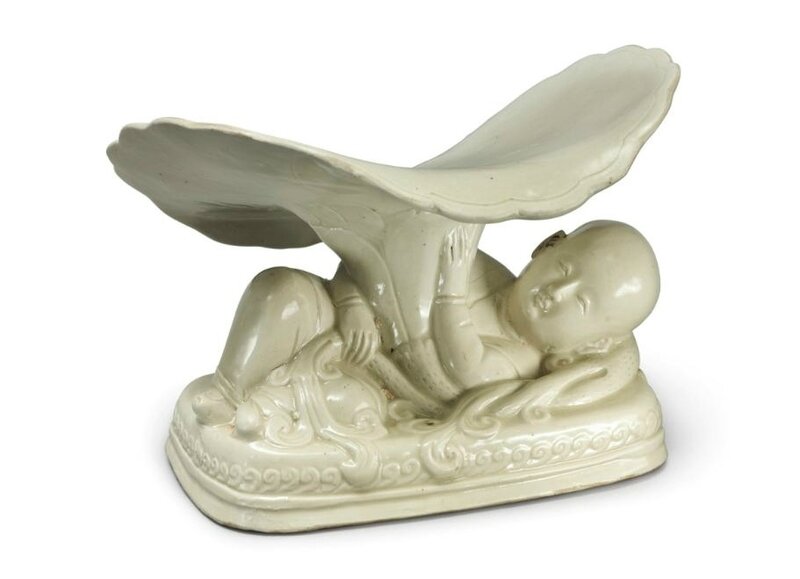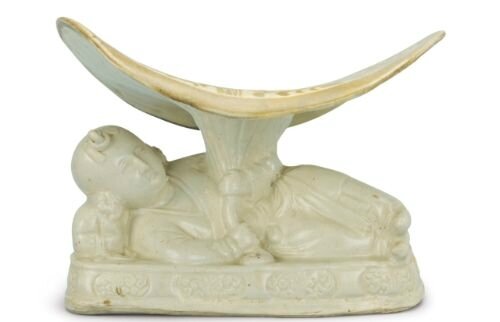A rare white ware 'Boy' pillow, Northern Song-Jin Dynasty
Lot 618. A rare white ware 'Boy' pillow, Northern Song-Jin Dynasty. Estimate 300,000 — 400,000 USD. Photo: Sotheby's.
well modeled in the form of a reclining boy cradling the stem and nestled beneath a large lotus leaf, the head resting on the long foliate stem curling around the body, the face with a calm expression detailed with half-closed eyes and a small mouth, all supported on a low plinth carved in relief with stylized water swirls above a raise fillet, covered overall with a soft transparent glaze pooling in the recesses. Width 8 in., 20.4 cm
Note: First manufactured in the Tang dynasty, ceramic pillows became popular and treasured items for the elite by the Song dynasty. Guides to elegant living printed in the Ming dynasty reveals that these pillows had functions beyond that of providing support while sleeping. The late Ming writer, Gao Lian, in the Cunsheng bajian [Eight discourses on the art of living], published in 1591, states that ‘porcelain may be used to make pillows… it has power to brighten the eyes and benefit the pupils’. He further notes that the immortal Yao used three scrolls with significant writings piled-up to make a pillow and ‘thereby he dreamed pure and elegant dreams’. Thus the material and the iconography of the pillow were of great importance in providing both health benefits and mediating between the conscious and unconscious as dreams were believed to have significant meaning in China.
The ceramic body was also beneficial as they were designed to cool the bed during hot summer nights. The Northern Song poet, Zhang Lei, in his poem Thanks to Master Huang for the Green Porcelain Pillow, wrote: ‘Pillow made by Gong is strong and blue; an old friend gave it to me to beat the heat; it cools down the room like a breeze; keeping my head cool while I sleep’.
The symbolism of the boy carrying a lotus leaf suggests this was created for the occasion of a marriage and the wish for the production of male heirs and is reference to the Song Dynasty custom of children imitating fertility-cult figurines, mohele, during the Qixi (Double Seven) festival. Ceramic pillows are commonly found decorated with the theme of playing children, as well as other motifs representing the blessing for a happy marriage, such as birds, flowers, butterflies and lions (to ward away evil spirits).
fig. 1. A carved ‘boy’ pillow, Northern Song dynasty © Museum of the Western Han Dynasty Mausoleum of the Nanyue King
Pillows in the form of boys were produced by a number of different kilns; for example, a Cizhou pillow of this type, also with a solid base, was gifted to the Museum of the Western Han Dynasty Mausoleum of the Nan Yue King, Guangzhou (fig. 1); and another, published in Cizhou yaoci zhen [Cizhou ceramic pillows], Beijing, 2000, p. 270. See a related Yaozhou pillow of this type, in the Meiyintang collection, illustrated in Regina Krahl, Chinese Ceramics from the Meiyintang Collection, vol. 3, pt. II, London, 2006, pl. 1479; and another, from the Jaehne collection in the Newark Museum, New Jersey, included in the exhibition Chinese Art from the Newark Museum, China Institute in America, New York, 1980, cat. no. 15. For sancai-glazed examples, see three pillows sold at auction, the first a carved Chengguan sancai-glazed pillow, attributed to the Northern Song dynasty, from the collection of Mark Lam, sold at Christie’s Hong Kong, 4th October 2016, lot 117; the second and third both sold in our London rooms, on 9th December 1986, lot 124 and 2nd March 1971, lot 137. See a Ding version, in the Meiyintang collection, illustrated in Regina Krahl, Chinese Ceramics from the Meiyintang Collection, vol. 3, pt. II, London, 2006, pl. 1428; and three others, published in Ding Yao Ceramics from the Beixuan Shuzhai Collection, Hong Kong, 2013, pls 14-16, together with two pillows in the form of reclining ladies, pls 17-18; another illustrated in Ding ci yi shu [The art of Ding porcelain], Hebei 2002, pl. 138, together with two pillows of reclining boys without a lotus leaf, pls 136-137; and a sixth example sold in these rooms, 23rd September 1995, lot 398. A similar Ding pillow, but now lacking its lotus leaf, in the Metropolitan Museum of Art, New York, included in Suzanne G. Valenstein, The Herzman Collection of Chinese Ceramics, New York, 1992, pl. 26; and another, but with the boy lying on his right side on a rectangular couch under a large lingzhi fungus, from the Avery Brundage collection in the Asian Art Museum of San Francisco, published in Ceramic Art of the World, vol. 12, 1977, col. pl. 12. Two qingbai pillows of boys similarly modelled supporting a headrest in the form of a lotus leaf are illustrated in Rose Kerr, Song Through 21st Century Eyes. Yaozhou and Qingbai Ceramics, Dreumel, 2009, pls. 2-15 and 2-16; another of a sleeping boy, included in the exhibition Ceramic Finds from Jingdezhen Kilns, Fung Ping Shan Museum, 1992, cat. no. 70; and a further example, in the Zhenjiang Museum, Zhenjiang, Jiangsu province, is included in Chinese Ceramics, Song Yuan Dynasty, Taipei, 1989, p. 382.

/https%3A%2F%2Fprofilepics.canalblog.com%2Fprofilepics%2F1%2F0%2F100183.jpg)
/https%3A%2F%2Fstorage.canalblog.com%2F03%2F02%2F119589%2F96711876_o.jpg)
/https%3A%2F%2Fstorage.canalblog.com%2F11%2F31%2F119589%2F94773502_o.jpg)
/https%3A%2F%2Fstorage.canalblog.com%2F20%2F83%2F119589%2F94772815_o.jpg)
/https%3A%2F%2Fstorage.canalblog.com%2F26%2F72%2F119589%2F75604929_o.jpg)
/https%3A%2F%2Fstorage.canalblog.com%2F59%2F60%2F119589%2F26458628_o.jpg)






/image%2F1371349%2F20240323%2Fob_5d83f1_2024-nyr-22642-0825-001-a-tall-painted.jpg)
/http%3A%2F%2Fstorage.canalblog.com%2F10%2F21%2F119589%2F128720387_o.jpg)
/http%3A%2F%2Fstorage.canalblog.com%2F10%2F39%2F119589%2F127811495_o.jpg)
/http%3A%2F%2Fstorage.canalblog.com%2F99%2F82%2F119589%2F126892955_o.jpg)